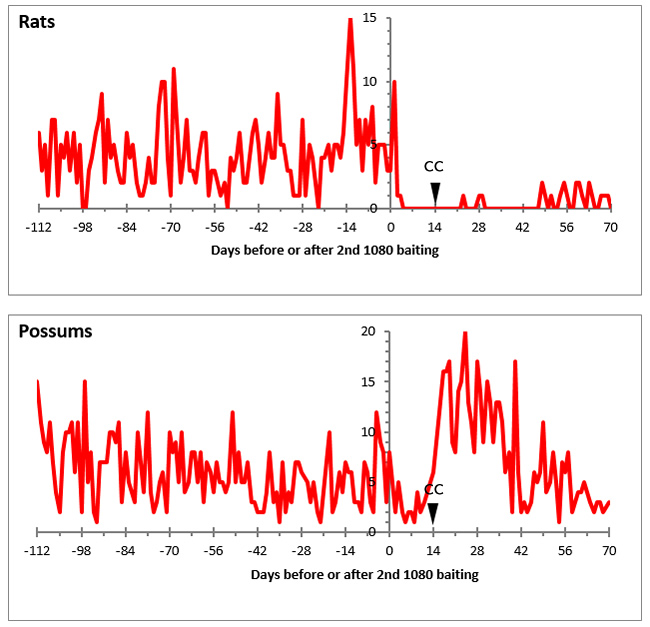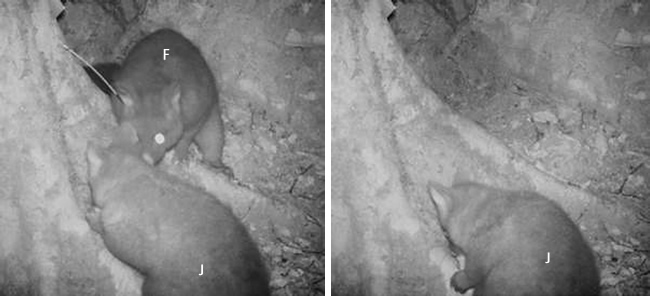Rapid-repeat ‘dual’ 1080: Can 1080 survivors be killed with a second sowing of 1080?
Achieving 100% kill of possums and rats in a single low-cost operation spanning just a few months is an aspirational goal for Manaaki Whenua − Landcare Research (MWLR) scientists Graham Nugent, Bruce Warburton and Grant Morriss. Doing so at very large scales in remote forest and mountain land would simultaneously result in such areas being immediately free of bovine tuberculosis (TB) in possums, and achieve local possum and rat freedom. This could greatly speed up progress towards the twin national goals of predator freedom by 2050 and eradication of TB by 2055.
The only currently available low-cost tool that can deliver close to 100% kills of both pest species over very large areas is two aerial pre-feeds of non-toxic bait followed by aerial 1080 baiting. However, post-baiting recovery of possum and rat populations suggests there will nearly always be a few survivors. Affordable ground-based options for locating and killing 1080 survivors are limited, so there is emerging interest in determining whether they could instead be killed using a further application of 1080 bait (i.e. ‘dual’ or rapid-repeat 1080).
In 2015 OSPRI commissioned MWLR to begin development of the dual 1080 concept. To kick things off the team met with experts from OSPRI, the Department of Conservation (DOC), and Zero Invasive Pests (ZIP) to design a possible approach. That workshop proposed a protocol comprising sequential application, about 2 months apart, of 1080 delivered in two different bait types, with each 1080 baiting round preceded by two non-toxic pre-feeds. A simple but crucial question was whether all or most of the (few) possums and rats that survived the first application of 1080 would be killed by the second. If not, the second application would be pointless.
In a first test of the method, a field team led by Grant used radio-tracking, chewcards, trail cameras, and bait acceptance trials to monitor the outcomes of three different 1080-baiting regimes in duplicate 100 ha blocks near New Creek, Westland. Both the first and second regimes involved a single broadcast application of 1080 in RS5 cereal bait sown at 2 kg/ha, and pre-fed either once (the usual operational protocol) or twice (the team’s recommendation for optimal kill efficacy). Both were highly effective, with all 75 radio-collared possums present in those four blocks killed during the first baiting in September 2016 (Table). Chewcards, baited and lured with peanut butter and cinnamon, were deployed to measure changes in pest activity. Over the next 9 months no possums were detected on the continuously deployed chewcards in two of the blocks, but a few survivors were detected in the other two. The pattern was the same for rats.
Table: Outcomes of three 1080 baiting regimes used in New Creek, showing the percentage kill of radio-collared possums and the percentage reduction in 7-night chew-card indices (CCIs) of possum and rat abundance achieved by the first cereal-1080 baiting (in September 2016), and the CCIs for possums and rats after a second baiting with EDR-coated cereal bait (in February 2017). Note: na = not applicable.
| Treatment | % kill (no. possums) 1st baiting | % reduction in possum CCI 1st baiting | % reduction in rat CCI 1st baiting | % reduction in possum CCI 2nd baiting | % reduction |
|---|---|---|---|---|---|
| No pre-feed | 98% (84) | 90% | 45% | No reduction | 100% |
| 1 ´ pre-feed | 100% (34) | 100% | 100% | na | na |
| 2 ´ pre-feed | 100% (41) | 100% | 100% | na | na |
The third regime (‘dual 1080’ baiting) was applied to four blocks and involved two applications of 1080 cereal bait. The first 1080 baiting was not preceded by non-toxic pre-feeding, so, as expected, there was some survival of both possums and rats. Bait acceptance trials showed that most if not all survivors would not eat any of the cereal bait type actually used in the first baiting, nor any of three other cereal bait types or carrot bait.
The subsequent second application of 1080 (in February 2017) involved a slightly different bait preparation (RS5 coated with Epro deer repellent [EDR], which changed the appearance and smell of the cereal bait). This was hand laid as either single baits randomly dispersed (in two blocks) or clusters of four baits (in two blocks) at 0.75 kg/ha, with the second baiting preceded by two aerial applications of the same EDR-coated RS5 bait in non-toxic form. Trail camera monitoring showed that rat activity immediately declined to zero following this second toxic baiting, with no rats detected until 3 weeks later (Figure). The second baiting with EDR-coated bait was clearly highly effective at killing rats, suggesting that pre-feeding twice with this second bait type had overcome their learned aversion to cereal bait from the first 1080 baiting.

For possums the picture was different. Trail camera activity dropped by about half for a few days but then sky-rocketed to twice the levels observed prior to the second round of 1080-baiting (Figure). The explanation for this apparent doubling of possum activity lies in the fact that freshly baited and lured chewcards were placed at each camera site about a week after the second 1080 baiting. This observation indicated that the second 1080 baiting had only killed, at best, half the possums, probably mostly just the juveniles that had not been independent at the time of the first baiting. Importantly, however, it also showed that despite their learned aversion to cereal bait types and carrot, survivors still ate the peanut butter-based paste in the chew-cards and returned frequently to check for more.

Overall, the trial suggests that the dual 1080 baiting concept merits further development. For rats, it appears that most learned aversion can be overcome by a twice-prefed second baiting, so the next step could be to test efficacy at large scales to answer the question: is the percentage kill actually 100% or ‘just’ 99.99% (one survivor per 10,000 rats)? Recent and current operations by ZIP will test this possibility (see http://zip.org.nz/findings/2017/11/1080-to-zero-trial-in-south-westland). For possums, a second baiting round using only a moderately different formulation of the same cereal bait appeared to have low efficacy, so is unwarranted. Somewhat serendipitously, however, we found that possums averse to cereal bait would readily eat a bait type that differed hugely in appearance, form, texture and taste, which suggests that a more drastic change of bait types could make a second baiting much more effective. Fortuitously, peanut butter-based prefeed and 1080 baits are already registered for possum control, albeit not yet for aerial delivery, so trials are underway to progress the dual 1080 baiting concept with such baits.
This work was funded by OSPRI through their TBfree programme.
Graham Nugent
nugentg@landcareresearch.co.nz
Grant Morriss
Bruce Warburton
